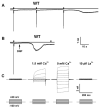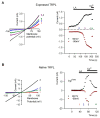The Role of Membrane Lipids in Light-Activation of Drosophila TRP Channels
- PMID: 35327573
- PMCID: PMC8945425
- DOI: 10.3390/biom12030382
The Role of Membrane Lipids in Light-Activation of Drosophila TRP Channels
Abstract
Transient Receptor Potential (TRP) channels constitute a large superfamily of polymodal channel proteins with diverse roles in many physiological and sensory systems that function both as ionotropic and metabotropic receptors. From the early days of TRP channel discovery, membrane lipids were suggested to play a fundamental role in channel activation and regulation. A prominent example is the Drosophila TRP and TRP-like (TRPL) channels, which are predominantly expressed in the visual system of Drosophila. Light activation of the TRP and TRPL channels, the founding members of the TRP channel superfamily, requires activation of phospholipase Cβ (PLC), which hydrolyzes phosphatidylinositol 4,5-bisphosphate (PIP2) into Diacylglycerol (DAG) and Inositol 1, 4,5-trisphosphate (IP3). However, the events required for channel gating downstream of PLC activation are still under debate and led to several hypotheses regarding the mechanisms by which lipids gate the channels. Despite many efforts, compelling evidence of the involvement of DAG accumulation, PIP2 depletion or IP3-mediated Ca2+ release in light activation of the TRP/TRPL channels are still lacking. Exogeneous application of poly unsaturated fatty acids (PUFAs), a product of DAG hydrolysis was demonstrated as an efficient way to activate the Drosophila TRP/TRPL channels. However, compelling evidence for the involvement of PUFAs in physiological light-activation of the TRP/TRPL channels is still lacking. Light-induced mechanical force generation was measured in photoreceptor cells prior to channel opening. This mechanical force depends on PLC activity, suggesting that the enzymatic activity of PLC converting PIP2 into DAG generates membrane tension, leading to mechanical gating of the channels. In this review, we will present the roles of membrane lipids in light activation of Drosophila TRP channels and present the many advantages of this model system in the exploration of TRP channel activation under physiological conditions.
Keywords: Diacylglycerol (DAG); Diacylglycerol kinase (DGK); Drosophila TRP channel; TRPL channel; cholesterol; ergosterol; methyl-β-cyclodextrin; phospholipase Cβ; poly unsaturated fatty acids (PUFAs).
Conflict of interest statement
Authors declare no conflict of interest.
Figures






Similar articles
-
Membrane lipid modulations by methyl-β-cyclodextrin uncouple the Drosophila light-activated phospholipase C from TRP and TRPL channel gating.J Biol Chem. 2024 Jan;300(1):105484. doi: 10.1016/j.jbc.2023.105484. Epub 2023 Nov 21. J Biol Chem. 2024. PMID: 37992804 Free PMC article.
-
Signal-dependent hydrolysis of phosphatidylinositol 4,5-bisphosphate without activation of phospholipase C: implications on gating of Drosophila TRPL (transient receptor potential-like) channel.J Biol Chem. 2012 Jan 6;287(2):1436-47. doi: 10.1074/jbc.M111.266585. Epub 2011 Nov 7. J Biol Chem. 2012. PMID: 22065576 Free PMC article.
-
Light-Induced Opening of the TRP Channel in Isolated Membrane Patches Excised from Photosensitive Microvilli from Drosophila Photoreceptors.Neuroscience. 2019 Jan 1;396:66-72. doi: 10.1016/j.neuroscience.2018.11.017. Epub 2018 Nov 17. Neuroscience. 2019. PMID: 30458219
-
Regulation of Drosophila TRP channels by lipid messengers.Novartis Found Symp. 2004;258:160-7; discussion 167-71, 263-6. Novartis Found Symp. 2004. PMID: 15104181 Review.
-
TRP channels in Drosophila photoreceptors: the lipid connection.Cell Calcium. 2003 May-Jun;33(5-6):385-93. doi: 10.1016/s0143-4160(03)00051-4. Cell Calcium. 2003. PMID: 12765684 Review.
Cited by
-
Critical contributions of pre-S1 shoulder and distal TRP box in DAG-activated TRPC6 channel by PIP2 regulation.Sci Rep. 2022 Jun 24;12(1):10766. doi: 10.1038/s41598-022-14766-x. Sci Rep. 2022. PMID: 35750783 Free PMC article.
-
Identification of sex-biased and neurodevelopment genes via brain transcriptome in Ostrinia furnacalis.Front Physiol. 2022 Aug 8;13:953538. doi: 10.3389/fphys.2022.953538. eCollection 2022. Front Physiol. 2022. PMID: 36003649 Free PMC article.
-
Proximity labeling reveals interactions necessary to maintain the distinct apical domains of Drosophila photoreceptors.J Cell Sci. 2024 Dec 1;137(23):jcs262223. doi: 10.1242/jcs.262223. Epub 2024 Dec 11. J Cell Sci. 2024. PMID: 39540276 Free PMC article.
References
Publication types
MeSH terms
Substances
LinkOut - more resources
Full Text Sources
Molecular Biology Databases
Miscellaneous

